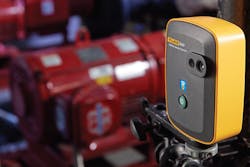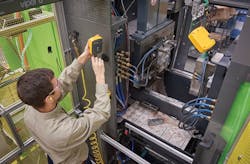Most maintenance managers are well acquainted with the panic of handling a critical equipment failure and investigating potential causes after the fact. In many cases, the damage requires major repairs or the repurchase of expensive equipment. Thermal monitoring using semifixed, wireless infrared sensors allows end users to have a proactive rather than reactive response to potential breakdowns or problems that could lead to failures in other equipment down the line. Thermal monitoring with infrared sensors offers the ability to compare images of a process or asset throughout its duty cycle.
A Processing Breakthrough Product of the Year, the fixed or semifixed mount Fluke 3550 FC Thermal Imaging Sensor, part of the Fluke Accelix platform, has user-defined monitoring cycles (1-, 5-,10-, 15-, 30- and 60-minute), which are shorter than typical route-based thermal inspection intervals. Issues are identified as they develop, and maintenance and reliability professionals can assess how quickly they need to take action and make better maintenance planning decisions.
What infrared sensors reveal
Using thermal monitoring with an infrared camera involves the basic identification of infrared images indicating hot and cold spots plus differences in temperature between similar units operating under similar conditions. When monitoring motors, fans, pumps and conveyors and performing thermal inspections of the bearings, shafts, casings, belts, gearboxes and other components that emit heat, infrared sensors can be used as indicators of equipment condition to prevent unexpected equipment breakdowns.
In specific processes, thermal monitoring with an infrared camera is ideal for discerning a lack of uniformity in equipment. For example, a thermal condition monitoring sensor can help facility managers spot temperate inconsistencies, such as a winding insulation failure, in a single motor. The software allows facilities to build heat profiles (via heat mapping) of a motor by capturing infrared images while the motor is fully operational under standard conditions.
How do they work?
Portable thermal imaging sensors can be installed on virtually any surface. They take sequential infrared images, thermal patterns of the surface temperature of equipment, and transmit those images to the cloud. Since heat is often an early indicator of degradation, baselining and identifying abnormal thermal patterns before failure helps extend the life of an asset and builds the facility’s condition-based or proactive maintenance capabilities.
These sensors are helpful in spotting abnormal thermal patterns such as high-resistance contact surface, load imbalances and failed components. They can also auto-capture and save infrared and visible light images for comparison in real time or whenever convenient.
Because the images are taken at regular intervals from the exact same location, comparison is simple. This is different from a handheld thermal imaging tool, which by its nature means that the user cannot be certain that the angle and distance are identical. Subsequently, images extracted from the handheld method may be difficult to compare. Troubleshooting intermittent problems requires personnel to be in the right place at the right time, which is not always possible. This infrared sensor solves the limitations of a fixed camera because it is semifixed (movable) and requires a cable connection to function.
Managers can compare and contrast multiple assets, so hot and cold spots stand out. The thermal sensor discussed in this article includes an adjustable bracket that can be positioned at numerous angles and nearly anywhere in a facility. A center target allows for the capture of temperature data of a component with suspected stability issues. Adding available software allows personnel to see that center point.
The browser-based software has cloud data storage, a mobile app for on-site use and connectivity to radioenabled test tools. The system transfers measurement data from test tools to a smartphone app, using pointto- point Bluetooth or Wi-Fi and requires no interaction with the local network. The smartphone app uses a cellular signal or Wi-Fi connection to transfer the data using a secure connection to the cloud data storage.
Because of features like automated routine data collection, report generation, graphs and the capability to save measurements directly to work orders, the software establishes a reliable, traceable asset history. When paired with thermal monitoring, users can accompany asset data with visual inspection images.
The thermal monitoring sensor is always on and the images can be viewed from anywhere at any time. It is flexible and mobile because it is wireless, operating on battery power. To begin, personnel should start with frequent images to identify how quickly a problem is developing. Then they can adjust the frequency to suit the monitoring needs. For example, if during normal operating conditions the surface temperature changes very slowly, the user can change the frequency from one image per minute to one image per 30 minutes. When plugged in and using AC power, the sensor can measure indefinitely.
The device’s battery life and bracket — which allow the sensor to rotate 360 degrees — highlight the importance of its flexibility. It should be mounted at a distance of 20 inches to 20 feet from the asset for the best accuracy. The sensor is securable using magnets or adhesive discs. All these features provide mobility and utility.
Common issues solved by infrared monitoring
No matter the industry or facility, faster response time to sudden mishaps avoids catastrophic failure and curtails damage costs. With thermal monitoring, maintenance, reliability and operations professionals can check for hot and cold spots more regularly, averting downtime and other problems. Temperature thresholds can also be determined and parameters can be set up in the software to send an alert to a user’s phone if thresholds are exceeded.
Some common problems maintenance managers face that can be helped by thermal monitoring are:
- Smaller teams: Many maintenance managers in mid-sized facilities with smaller teams find performing regular equipment checkups with a thermal imager difficult, so they often outsource this function to consultants. This tool allows team members to begin taking routine thermal images without third-party intervention. Managers can replace some thermal inspection route-based maintenance with automated sequential images.
- Reactive mindset: Because many facilities house seemingly countless components, from rotating assets to small transformers, chasing problems as they surface strains even the most capable maintenance managers.
- Poor response time: If personnel is spread thin and professionals are constantly hustling to handle the latest equipment failure, response time can suffer.
Thermal monitoring with infrared sensors aims to alleviate these all-too-common headaches. The sensors keep "eyes" on equipment, no matter the time of day.
Six benefits of infrared monitoring
The six ways that thermal monitoring, specifically with a connected sensor, can positively affect a preventive maintenance program are:
1. Proactive maintenance
Many equipment’s failure mechanisms involve a significant rise or drop in operating temperature before catastrophic failure occurs. Issues that seem insignificant at first may lead to downtime if they go unchecked, which can affect the bottom line. Thermal imaging sensors let personnel recognize measurement variations and prioritize situations that demand an urgent response.
2. No shutdowns, less downtime
The thermal imaging sensor is non-invasive and can be installed on some assets while they are operating. Teams develop a better idea of the overall health of a facility’s equipment and face less unexpected downtime.
3. Safer employees
Thermal images are taken automatically by the sensor, so technicians will not have to be close to operating equipment. The sensors have minimal safety risks (except for live voltage — which still requires full electrical safety precautions).
4. Labor impact
Thermal inspections with a sensor can cover more ground and find problems in areas that might typically be ignored because they are difficult for personnel to access. When end users position and secure (via a magnet, a bracket or authorized adhesives) a thermal imaging sensor, a team can monitor more equipment with more precision.
5. Accessibility
Thermal images can monitor hard-to-reach components and assets operating throughout the night that may not otherwise be measurable. Also, thermal sensors help detect imminent failures in nearly all types of automated equipment — electrical, mechanical, process and electronic — in an enclosure or difficultto- reach place.
6. Improved ROI
Having sequential thermal images stored on the cloud and accessible on mobile devices or computer desktops creates equipment histories. Having this knowledge onhand saves time and avoids personnel having to search for baseline measurements. It also lets maintenance managers conduct smarter evaluations.
These six payoffs work in concert with a monitoring system, which supplies more indicator data versatility
More indicator data versatility with condition monitoring
The thermal monitoring sensor is designed to be seamlessly integrated into a preventive maintenance software platform, which can be used to gather data from many different sensor types. It wirelessly links test tools and sensors to smartphones and to the cloud where measurements can be viewed, graphed, shared and stored for trending and further analysis. The thermal imaging sensor cannot operate without the condition monitoring software.
The thermal imaging sensor wirelessly links to connected devices and to the cloud, where measurements can be viewed, graphed, shared and stored for trending and further analysis.
A technician or sensor takes measurements — electrical or temperature (infrared or thermocouple) — and the software automatically saves the data and uploads it to the cloud. From there, end users can correlate different types of measurements taken by different devices (handheld or semifixed) — volts, current or infrared images — to identify equipment issues. For example, excess heat may indicate a current spike in a motor or pump, so taking concurrent measurements captures a better picture of overall equipment health.
The infrared sensor monitors a pair of motors.
First, the end user sets thresholds for measurements. The condition monitoring software then sends image data directly to a device or computer when those custom thresholds are exceeded. The notifications allow the end user to associate the measurements to equipment, build hierarchies and track historical trends.
Five applications for thermal monitoring with infrared sensors
Thermal monitoring with infrared camera sensors, when combined with voltage, current, power quality and temperature sensors, have a wealth of applications for equipment common to many facilities. A few examples are:
- Pumps, motors, drives and compressors: Thermal imaging is especially useful for monitoring rotating equipment, since many impending failures are accompanied by overheating. Personnel can use the sensor to quickly compare the surface temperatures of multiple motors in a row. This predictive technique uses a thermal imaging sensor to capture two-dimensional images representing the apparent surface temperatures of equipment.
- Process instrumentation: Pipes, hoses and valves are crucial to delivering fluids to processes at precise moments. Thermal image sensors can indicate leaks, stuck valves or tube blockages and can be mounted near machinery inside enclosures. Proactive thermal monitoring in pipes can help spot obstructions before an entire loop fails. Apart from knowing insulation specifications and the material the tank is constructed of, thermal monitoring lets technicians monitor liquid levels and rough checks of dry bulk material levels.
- HVAC systems and condensers: In data centers, where cooling is important to keep servers from overheating, uncharacteristically cool surfaces might also indicate a problem, perhaps an imbalance in the heating, ventilation and air conditioning (HVAC) system. Thermal imaging sensors can monitor server racks or be used in HVAC systems to monitor valves and condensers.
- Small transformers: Thermal monitoring helps quickly identify bad electrical connections, imbalances, overloads, harmonics and other impending electrical equipment failures. End users can spot uneven or inadequate power supply, then take corrective action on the power supply and prevent downtime. This also applies to electrical systems, which are a major application area for thermal monitoring with infrared sensors.
- Precommissioning tests: Technicians need to conduct mechanical, electrical and visual tests before a new transformer can be commissioned in the field. When combined with a condition monitoring system and software, the sensors — for voltage, current, temperature and thermal imaging — can provide data confirming that the transformer is operating correctly and establish baseline data for future checks.
Four key advantages of semifixed thermal imagers
1. Troubleshooting: By automatically capturing a series of thermal images, the wireless sensor helps spot abnormalities that develop over a period of time.
2. Versatility: The sensors include a bracket with 360-degree gimbal — which can be mounted with a magnet, screws or adhesive — making them easily fixed and easily movable.
3. Data correlation: The condition monitoring software enables end users to receive alarms based on user-set thresholds; remotely monitor multiple assets; and produce multiple graphs per asset that correlate current, voltage, temperature and power monitoring. Adding thermal images helps correlate visual inspection to the data.
4. Mobility: The sensors can operate on battery power, which allows end users to move the sensors to different assets in the facility and reposition them no matter how awkward the angle or line of sight. This also keeps technicians out of harm’s way when taking thermal readings.
Alex Desselle is a product application specialist with Fluke Digital Systems and Accelix, a Fluke platform. With more than 30 years of experience, Desselle has been a lead field engineer, product manager and subject matter expert in the oil and gas, chemical and manufacturing industries. He may be reached at [email protected]. For more information about Fluke Connect sensors, software or tools, visit www.connect.fluke.com.





